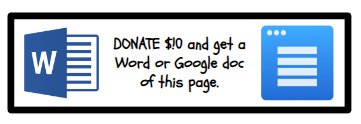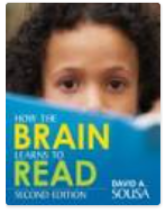

Reading Comprehension
The following page numbers refer to David Sousa’s How the Brain Learns to Read, 2nd Edition.
- Reading comprehension depends heavily on spoken language comprehension. As children master the skill of word comprehension, their reading comprehension improves dramatically (p. 95).
- To develop reading comprehension, children must build their vocabulary and linguistic knowledge and thoughtfully interact with the text to derive meaning (p. 95).
- Oral vocabulary becomes the basis for comprehension in reading (p. 96).
- The larger the child’s oral vocabulary, the easier it is to understand the text. However, if the word is not in the child’s lexicon, he will need to determine meaning through other ways (p. 96).
- Some vocabulary must be taught directly, but most language is taught indirectly (p. 96).
- Children learn new words indirectly through oral and written language. However, they learn directly when explicitly taught individual words and word-learning strategies (p. 96).
- Direct instruction effectively teaches words representing complex concepts that are not part of everyday experiences (p. 97).
- Repeated exposure to new words aids word learning and linguistic knowledge. Children need to see, hear, and read specific words to learn them and understand their various meanings (p. 97).
- Factors such as ability, age, and text density impact students’ chances to learn new words in context (p. 97).
- Low-ability students only have an 8% chance of learning new words in context, and 19% for high-ability students. 4th graders have an 8% chance, while 11th graders have a 33% chance (p. 97).
- When text density is low (1 new word/150), the greater the chance of learning a new word (30%). However, the chances drop to 7% when there is one new word per 10 (p. 97).
- Linguistic knowledge: hear, distinguish, and categorize speech sounds (phonology), understand the rules of how words are put together in phrases and sentences (syntax), and understand the meaning of individual words and sentences and the relationships between them (semantics) (p. 97).
- Please see pages 98-100 in David Sousa’s How the Brain Learns to Read for a “How to Teach Vocabulary” chart.
- Children who first learn to read use substantial mental effort to sound out words, so fewer cerebral resources remain for text comprehension (p. 100).
- It is critical to develop fluency in word recognition. When fluent, word recognition requires far less mental effort, and it frees up the child’s cognitive capacity for understanding what is read (p. 100).
- Explicit instruction in word recognition to the point of fluency is vital for text comprehension (p. 100).
- Tan and Nicholson (1997) showed struggling primary readers who were taught new words with instruction that emphasized recognition to the point of fluency ~ reading words in isolation ~ answered more comprehension questions than those whose emphasis was on meanings (p. 101).
- Discussions before reading improve comprehension, and activating prior knowledge improves fluency (p. 101).
- Possessing prior knowledge could stimulate neural networks and visual processing sites, making word recognition less challenging (p. 101).
- Good readers read for a purpose and actively use their personal experience and knowledge (p. 101).
- Text comprehension is improved with direct, explicit instruction, including self-monitoring, graphic and semantic organizers, answering questions, generating questions, recognizing story structure, and summarizing (p. 101).
- Teaching strategies in the context of specific academic areas is best. Cooperative learning helps help students understand content-area texts (p. 102).
- Please see pages 102-107 in David Sousa’s How the Brain Learns to Read for a “How to Teach Comprehension” chart.
- Teach students to become critical readers by fostering inquiry ~ and encouraging students to question, make predictions, and support value judgments. This employs higher-order thinking skills (p. 107).
- Critical reading strategies include: previewing, contextualizing (recognizing their own values, time, and place vs. those in text), questioning (this helps in retaining new learning), challenging beliefs, evaluating an argument, outlining/summarizing, comparing/contrasting the arguments of various authors (p. 108).
- To sharpen critical reading skills, ask questions about the reader, writer, the writer’s arguments, evidence, conclusions, the writer’s use of evidence to support the conclusion, and the reader’s reaction to the reading (p. 109).
- Critical reading in secondary schools helps students confidently handle complex material (p. 109).
- Research suggests initial reading instruction in a child’s home language contributes positively to a child’s ability to retain literacy in both languages and prevents reading difficulties (p. 110).
- Literacy and other skills and knowledge transfer across languages (p. 110).
- Reading in any language requires a solid mental lexicon of spoken vocabulary (p. 110).
- Learning to read for meaning depends on comprehending the text’s language (p. 110).
- Cooperative learning is appropriate for bilingual education (p. 111).
- BCIRC, or Bilingual Cooperative Integrated Reading Cooperative, assigns students to 4 heterogeneous member teams after a lesson. Students first work in their native language and then transition to English. This model has been particularly effective. The teachers do the following 15 strategies before, during, and after reading during a 5-day cycle: build background/vocabulary, make predictions, read, partner/silent read, treasure hunt, map the story, retell, story-related writing, say words aloud/spell, check the partner, make meaningful sentences, take tests, direct instruction in reading comprehension, writing workshops, independent reading (p. 112-114).
![]()


